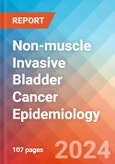Key Highlights
- In 2023, in the 7MM there were around 1,500,000 diagnosed prevalent cases of NMIBC.
- In 2023, the highest cases of NMIBC were at stage Ta, followed by T1 and Tis in the United States, while PUN-LMP accounted for the least prevalent stage, with ~6,800 cases in 2023
- NMIBC is an age-associated malignancy, with a median age at diagnosis of 73 years and individuals aged 70-90 years accounting for the largest percentage.
- In Japan, the highest number of stage-specific cases of NMIBC was in the Ta stage, accounting for approximately 60% in 2023.
Geography Covered
- The United States
- EU4 (Germany, France, Italy, and Spain) and the United Kingdom
- Japan
Study Period: 2020-2034
Non-muscle Invasive Bladder Cancer Disease Understanding
Non-muscle Invasive Bladder Cancer Overview
Non-muscle-invasive bladder cancer represents a category of bladder cancer where the tumor is confined to the innermost layer of the bladder lining without invading the muscle. This early-stage form accounts for a significant proportion of bladder cancer cases. NMIBC is often characterized by superficial tumor growth and typically presents with papillary tumors or carcinoma in situ. Due to its propensity for recurrence and progression, NMIBC requires vigilant management involving transurethral resection of the tumor (TURBT) and subsequent intravesical therapies like Bacillus Calmette-Guérin (BCG) immunotherapy or chemotherapy. Surveillance through regular cystoscopies and adherence to guidelines are essential to monitor and manage this condition effectively.Non-muscle Invasive Bladder Cancer Diagnosis
The diagnosis of NMIBC relies upon cystoscopy and tissue sampling. Initial cystoscopic evaluation is often performed in the office setting with or without biopsies of visualized tumors(s). Flexible cystoscopy in conjunction with topical intraurethral anesthetic lubricant decreases patient discomfort during the procedure, particularly in men. Most cases of NMIBC are initially treated with transurethral resection, but careful cystoscopic examination of the entire urethra and bladder should precede resection. However, surgeons may proceed directly to TURBT should CT or MRI reveal a bladder lesion during the evaluation of hematuria. During resection, tumors of significant size should be resected and labeled. The anatomic location of tumors with respect to the bladder neck and ureteral orifices, tumor configuration (papillary or sessile), as well as both the size and number of tumors should be documented in some consistent manner (e.g., diagram, text description) to inform future follow-up and evaluate treatment response.Non-muscle Invasive Bladder Cancer Epidemiology
The report's Non-muscle invasive bladder cancer (NMIBC) epidemiology chapter provides historical as well as forecasted epidemiology segmented by the total prevalent cases of NMIBC, stage-specific cases of NMIBC, grade-specific cases of NMIBC, risk-specific cases of NMIBC, and age-specific cases of NMIBC in the 7MM covering the United States, EU4 (Germany, France, Italy, and Spain), the United Kingdom, and Japan from 2020 to 2034.- Among the 7MM, the US accounted for the highest number of cases in 2023, with around 600,000 prevalent cases; these cases are expected to increase during the forecast period.
- In 2023, the total number of prevalent cases of NMIBC in EU4 and the UK was maximum in Italy, while the lowest number of cases was in France.
- Among cases categorized by risk level, the highest number belonged to the intermediate-risk category, whereas the lowest number was associated with the high-risk category.
- According to the estimates, in Japan, NMIBC was most prevalent in the 70-89 age group, accounting for approximately 60% of total cases in 2023.
Scope of the Report
- The report covers a segment of critical events, an executive summary, descriptive overview of Non-muscle Invasive Bladder Cancer, explaining its causes, signs and symptoms, pathogenesis, and diagnostic approaches.
- Comprehensive insight has been provided into the epidemiology segments and forecasts, the future growth potential of diagnosis rate, and disease progression.
- A detailed review of the Non-muscle Invasive Bladder Cancer epidemiology, detailed assumptions, and rationale behind our approach is included in the report.
- A detailed review of current challenges in establishing the diagnosis.
Non-muscle Invasive Bladder Cancer Report Insights
- Patient Population
- Country-wise Epidemiology Distribution
- Age-specific Cases of Non-muscle Invasive Bladder Cancer
- Stage-specific Cases of Non-muscle Invasive Bladder Cancer
Non-muscle Invasive Bladder Cancer Report Key Strengths
- Eleven Years Forecast
- The 7MM Coverage
- Non-muscle Invasive Bladder Cancer Epidemiology Segmentation
Non-muscle Invasive Bladder Cancer Report Assessment
- Epidemiology Segmentation
- Current Diagnostic Practices
Epidemiology Insights
- What are the disease risks, burdens, and unmet needs of Non-muscle Invasive Bladder Cancer? What will be the growth opportunities across the 7MM concerning the patient population with Non-muscle Invasive Bladder Cancer?
- What is the historical and forecasted patient pool for Non-muscle Invasive Bladder Cancer in the United States, EU4 (Germany, France, Italy, and Spain), the United Kingdom, and Japan?
- Which stage-specific cases of Non-muscle Invasive Bladder Cancer is the most significant contributor?
- What is the diagnosis rate of Non-muscle Invasive Bladder Cancer?
Reasons to Buy
- Insights on patient burden/disease, evolution in diagnosis, and factors contributing to the change in the epidemiology of the disease during the forecast years.
- To understand the age-specific Non-muscle Invasive Bladder Cancer prevalent cases in varying geographies over the coming years.
- A detailed overview of grade-specific and gender-specific cases of Non-muscle Invasive Bladder Cancer is an inclusion.
- To understand the perspective of key opinion leaders around the current challenges with establishing the diagnosis and insights on the recurrent and treatment-eligible patient pool.
- Detailed insights on various factors hampering disease diagnosis and other existing diagnostic challenges.
Table of Contents
1. Key Insights2. Report Introduction3. Executive Summary of NMIBC5. Epidemiology Methodology9. Publisher Capabilities10. Disclaimer11. About the Publisher
4. NMIBC Epidemiology Overview at a Glance
6. Disease Background and Overview: Non-muscle Invasive Bladder Cancer (NMIBC)
7. Epidemiology and Patient Population
8. Appendix
List of Tables
List of Figures








